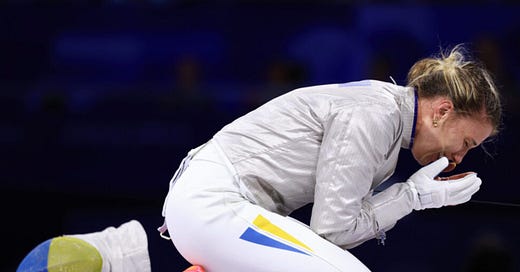What the Olympics Can Teach Us About Storytelling
Introduce NBC's Five Magnets to Your Students

There may not be any crying in baseball, but the Olympics are a different story. Have I teared up on my couch at least once every night since July 26?
You bet.
Like when gymnast Brody Malone’s father read a letter to his son on air and couldn’t get through it.
Or when the surging cheers inside La Defense Arena met Leon Marchand every time he broke the water, and then later when he stood on the awards podium and sang "La Marseillaise" with the crowd (and me at home channeling my inner Madeleine Lebeau).
Or when Tik Tok icon Ilona Maher talked about being part of something bigger than her own efforts, about the legacy she wants to leave for young girls who may “pass through the jersey” on a professional rugby team
Or when Ukrainian fencing star Olga Kharlan won her country’s first medal in the women’s saber event and dedicated it to all the Ukrainian athletes “who couldn’t come here because they were killed by Russia.”
Or when Simone Biles dominated an event she pulled out of in Tokyo for her mental health.
And, of course, when the squinting pommel horse dude pommel horses.
Because these moments are not just about competition, these moments are human stories crafted to make us care. Reading an emotional letter might be outside the scope of aerial dismount commentary, but the letter doesn’t negate our investment in Malone’s event, it increases it.
We aren’t just watching a gymnast on the rings; we are watching a human through the lens of backstory - the loss of his mother to cancer, a catastrophic leg injury, three surgeries, learning to walk again.
I am cheering for him because—in a way not possible with a box score— I know him. The moments are television gold due to their great storytelling.
As Kyle Vanhemert wrote for Wired in 2016, NBC's Olympics broadcast “is a rigorously crafted product, one based on the counterintuitive idea that the Games is not a series of athletic contests, but a mosaic of deeply human stories.”
The brainchild of producer Dick Ebersol, NBC’s Olympics abandoned the traditional coverage loved by die-hard sports fans - the box scores and the play-by-play - and embraced a mode of storytelling that uses five “magnets” to draw people in night after night for events as obscure as race walking or marathon swimming.
Here they are:
Magnet #1
The first magnet is “narrative momentum.” This element draws us to the Games because we are watching “a grand story, with individual contests comprising but a single thread.” In fiction, narrative momentum is the element of the story that keeps the reader turning the page, moving along the arc of the story.
Magnet #2
The second magnet attracting viewers is the fact that sports are unscripted, the best kind of live theater. The Games follow predictable rules, but anything can happen in any event to any competitor. The Miracle on Ice. Greg Louganis diving after striking his head on the springboard. Mary Decker grimacing on the ground as the 18-year-old South African Zola Budd ran barefoot ahead of her.
Magnet #3
Suspense is the third magnet. People watch the Games for the delightful tension created by their unpredictability. Who will experience the thrill of victory? Who will experience the agony of defeat? Stories that underscore the stakes of these events, stories couched in a sense of foreboding keep us in our seats.
Magnet #4
The fourth magnet that draws viewers is the spirit of the Games. We value and idealize the nobility, the history, the international sense of goodwill that the Olympics promotes. From a fictional angle, this magnet might serve as the big universal theme of mutual understanding to help build a better, more peaceful world.
Magnet #5
The fifth magnet NBC uses in storytelling grounds the stories in the patriotism viewers feel for their country, and more expansively, the feelings viewers feel for all the competitors striving for the human race and the world.
Consider introducing these magnets to students as a storytelling template.
Magnet 1: Attach your scenes to an arc strong and large enough to create narrative momentum that propels the reader forward.
Magnet 2: Write your fiction as if it’s not fiction and as if it’s not writing. Write fiction that feels like unscripted life, or as John Gardner said, “that of the vivid and continuous fictional dream.”
Magnet 3: Build suspense by raising the stakes, embedding irony and foreshadowing.
Magnet 4 and 5: Underpin your story with a large premise or a universal theme that provides depth and resonance to the decisions your characters make.
And finally, be judicious about how you arrange the scenes in a piece of fiction. The framing of the Big Story of the Olympics represents a sort of puzzle, “each piece meticulously arranged to ensure maximum engagement.” NBC uses the concept of “linkage,” to interlock each story of heroism to other stories of redemption or defeat, which builds throughout the broadcast.




Liz, thank you for another brilliant bit of insight! My husband insists on watching every minute of every Olympics, and I always grumble, not being a huge sports fan. But after a few nights, I find myself drawn in. I'm still puzzled/disappointed by many of the choices they make in their coverage, but this magnet concept is fascinating.
By the way, did you see Ted Chiang's piece in The New Yorker on AI and creativity last week? It mentions the Gemini ad, and that it was pulled after a huge outcry. Whew!